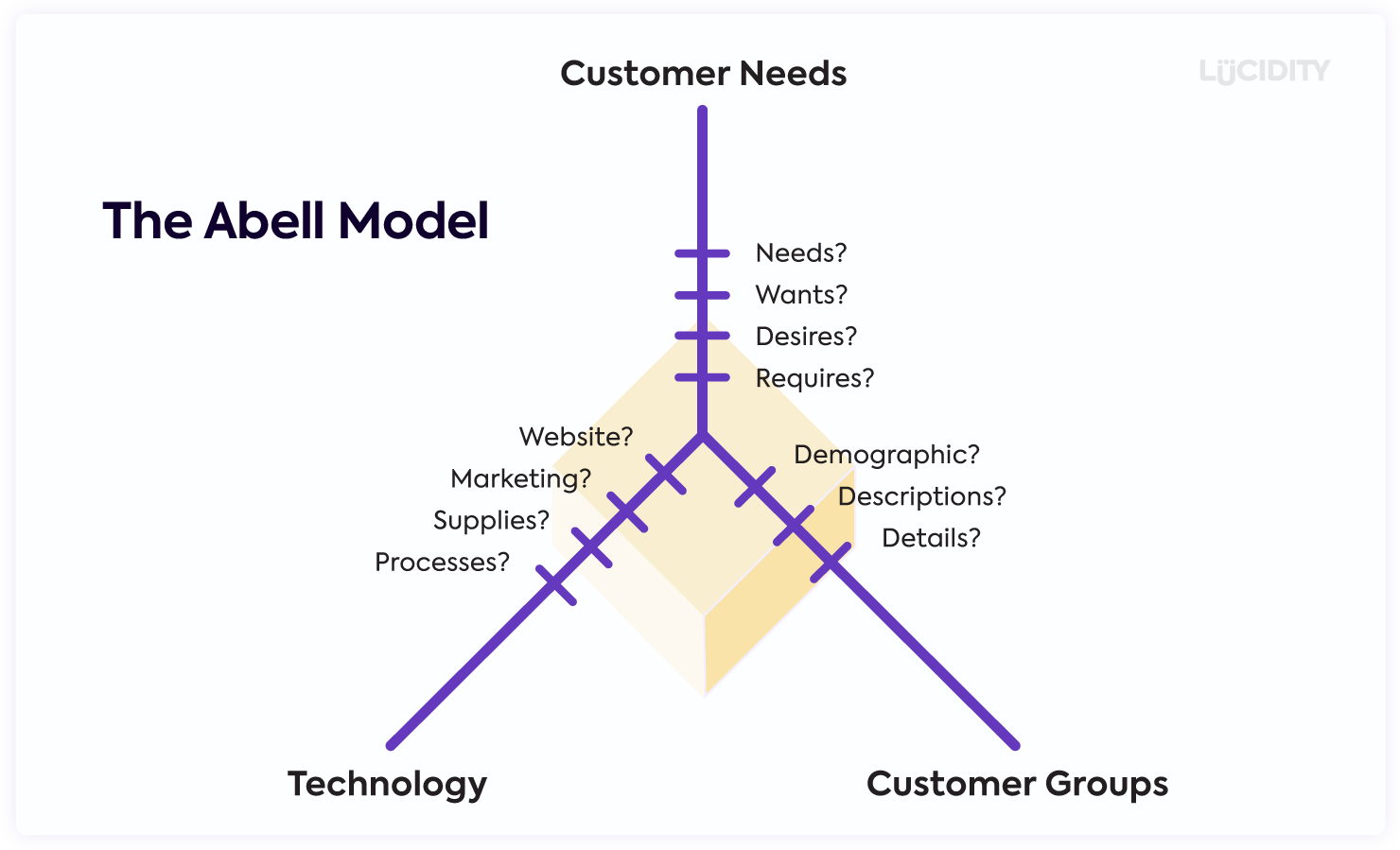The Abell Model has a number of names. It’s sometimes referred to the Abell Matrix, other times it’s known as the Three Dimensional Business Definition Model. Catchy!
However you refer to it (we’re going to go for Abell Model), it’s a great way to map out the way your business is going to be successful and help inform your strategic planning.
Let’s learn a little more…
What is the Abell Model?
The Abell Model is a three dimensional framework that’s used to describe and map out a business model and activities. It’s useful for making clear how a business operates today, to help inform future strategic planning. It is basically about establishing the fundamental aspects of any business, asking three top-level questions:
- Who are the business’ customers?
- How does the business help them?
- How do they deliver that product or service to these customers?
Those questions constitute the three dimensions in this model. They are:
- Customer Groups
- Customer Needs
- Technologies
As the above illustrates, this model has a leaning towards the customer. Two of the three dimensions focus on it, highlighting the importance of thinking about the customer when you are developing your strategies. If you’re thinking about focusing on one particular area, it might be worth reading our guide to Porter’s Value Disciplines. Porter talks about success requiring specialism in a certain area, one of which is customers.
What are Customer Groups in the Abell Model?
In the Abell Model Customer Groups refers to who the business is targeting. To be successful it’s important a business knows who their audience is, as without this they won’t be able to segment, target, or construct the right messages.
To help you define your Customer Groups consider:
- What are the demographics of our customers?
- Are we B2B or B2C?
- What personas have we created around our buyers?
- What common traits do our customers have?
- Have we ever lost a customer due to not being a good fit? If so, why?
You may also find our guide to Revenue Segmentation useful when it comes to thinking about how to group your customers.
What are Customer Needs in the Abell Model?
Customer Needs is the dimension focusing on the problems you are solving for your customers. What they need, want, desire, require, are noted in this dimension. Here you compile a list of everything your customers want and need. This is a critical aspect of the model as this list contains all the reasons your customers buy from you.
To help you define your Customer Needs consider:
- What problems do our customers have?
- Why do customers buy from us?
- What feedback do we get from our customers, both positive and negative?
- What features of our product and service are being used?
- If B2B, how do we help our customers make or save money?
What are Technologies in the Abell Model?
The Technologies dimension describes everything that is used when developing and selling a product or service to the customers in order to meet those needs. Despite the name, it does not specifically refer only to technology. It can include marketing.
To help you define Technologies consider:
- What inputs do we need to make our product or service?
- Who are our suppliers?
- How do customers purchase our product or service?
- How do customers interact with us?
- How do new customers get to know about us?
In both Technologies and Customer Needs, a useful exercise would be to go through a Customer Survey, in order to get answers to some of these questions and provide feedback to your Abell Model.
Abell Model Example
Let’s take a look at two examples:
Sony PlayStation
PlayStation (currently in it’s 5th iteration) is a console used by millions to play games. It’s a complicated business so we’ll just touch on some example areas in their Abell…
Customer Groups:
- Gaming adults
- Children
- Teenagers
- eSports players
Customer Needs:
- Multiplayer support
- Large catalogue of games
- Good graphics/sound
Technologies:
- Third party game makers
- Heavy digital marketing
- Hosted servers for multiplayer
- TV & sponsorship
IKEA
The international furniture chain has a global audience of shoppers buying flat pack furniture…and meatballs. Like PlayStation, IKEA is complicated. Let’s take a look at some of the aspects of their Abell below…
Customer Groups:
- Families
- Often in urban locations
Customer Needs:
- Space saving solutions
- Affordable price points
- Ease of construction
Technologies:
- R&D and manufacturing
- Website
- Locations of physical stores
Why is the Abell Model used?
The primary use is to clearly and exactly map out a company’s business model. Understanding customers, the problems the business solves, and how it solves it, is really important to be able to develop strategic plans that are going to work against the competition.
By working through the Abell Model for your business you’ll have a comprehensive list of all the customers you serve and how you serve them. This can also help you spot opportunities – other customer needs you are not meeting, other customer groups that could benefit from your solution, new ‘technologies’ that could help you deliver your product or service more successfully.
The Abell Model can also be used to profile competitors for use internally, helping employees onboard rapidly and effectively, particularly in sales and marketing.
What are the limitations of the Abell Model?
There are a couple of limitations to consider if you intend to use the Abell Model:
- There’s no external analysis for the business factored in the model
- It’s very weighted towards customers, rather than other considerations
- It can struggle to provide the depth of detail in just three dimensions
- Diagrammatically, it’s not the simplest framework for employees to consume
Who invented the Abell Model?
Prof. Derek F. Abell, Professor Emeritus at the European School of Management and Technology in Berlin, developed the Abell Model. He first proposed it in the book “Defining The Business”, published in 1980.
Now you understand the Abell Model (or the Abell Matrix, or the Three Dimensional Business Definition Model), it’s time to write out your three lists and truly understand how your business works and what opportunities you may be able to add into your strategic planning. Good luck!















